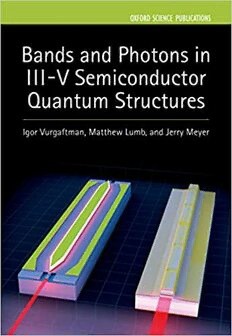Table Of ContentOUPCORRECTEDPROOF – FINAL,31/10/2020,SPi
SERIES ON SEMICONDUCTOR
SCIENCE AND TECHNOLOGY
SeriesEditors
R.J.Nicholas UniversityofOxford
H.Kamimura UniversityofTokyo
OUPCORRECTEDPROOF – FINAL,31/10/2020,SPi
SERIESONSEMICONDUCTORSCIENCEANDTECHNOLOGY
1. M.Jaros:Physicsandapplicationsofsemiconductormicrostructures
2. V.N.DobrovolskyandV.G.Litovchenko:Surfaceelectronictransportphenom-
enainsemiconductors
3. M.J.Kelly:Low-dimensionalsemiconductors
4. P.K.Basu:Theoryofopticalprocessesinsemiconductors
5. N.Balkan:Hotelectronsinsemiconductors
6. B.Gil:GroupIIInitridesemiconductorcompounds:physicsandapplications
7. M.Sugawara:Plasmaetching
8. M.Balkanski,R.F.Wallis:Semiconductorphysicsandapplications
9. B.Gil:Low-dimensionalnitridesemiconductors
10. L.Challis:Electron-phononinteractionsinlow-dimensionalstructures
11. V.Ustinov,A.Zhukov,A.Egorov,N.Maleev:Quantumdotlasers
12. H.Spieler:Semiconductordetectorsystems
13. S.Maekawa:Conceptsinspinelectronics
14. S.D.Ganichev,W.Prettl:Intenseterahertzexcitationofsemiconductors
15. N.Miura:Physicsofsemiconductorsinhighmagneticfields
16. A.V.Kavokin,J.J.Baumberg,G.Malpuech,F.P.Laussy:Microcavities
17. S.Maekawa,S.O.Valenzuela,E.Saitoh,T.Kimura:Spincurrent
18. B.Gil:III-nitridesemiconductorsandtheirmoderndevices
19. A.Toropov,T.Shubina:PlasmonicEffectsinMetal-Semiconductor
Nanostructures
20. B.K.Ridley:HybridPhononsinNanostructures
21. A.V.Kavokin,J.J.Baumberg,G.Malpuech,F.P.Laussy:Microcavities,Second
edition
22. S. Maekawa, S. O. Valenzuela, E. Saitoh, T. Kimura: Spin current, Second
Edition
23. M.M.Glazov:Electronandnuclearspindynamicsinsemiconductor
nanostructures
24. D. Meier, J. Seidel, M. Gregg, R. Ramesh: Domain walls:from fundamental
propertiestonanotechnologyconcepts
25. I.Vurgaftman,M.Lumb,J.Meyer:BandsandphotonsinIII-Vsemiconductor
quantumstructures
OUPCORRECTEDPROOF – FINAL,31/10/2020,SPi
Bands and Photons in III–V
Semiconductor Quantum Structures
Igor Vurgaftman, Matthew P. Lumb, and Jerry R. Meyer
1
OUPCORRECTEDPROOF – FINAL,31/10/2020,SPi
3
GreatClarendonStreet,Oxford,OX26DP,
UnitedKingdom
OxfordUniversityPressisadepartmentoftheUniversityofOxford.
ItfurtherstheUniversity’sobjectiveofexcellenceinresearch,scholarship,
andeducationbypublishingworldwide.Oxfordisaregisteredtrademarkof
OxfordUniversityPressintheUKandincertainothercountries
©Vurgaftman,Lumb,andMeyer2021
Themoralrightsoftheauthorshavebeenasserted
FirstEditionpublishedin2021
Impression:1
Allrightsreserved.Nopartofthispublicationmaybereproduced,storedin
aretrievalsystem,ortransmitted,inanyformorbyanymeans,withoutthe
priorpermissioninwritingofOxfordUniversityPress,orasexpresslypermitted
bylaw,bylicenceorundertermsagreedwiththeappropriatereprographics
rightsorganization.Enquiriesconcerningreproductionoutsidethescopeofthe
aboveshouldbesenttotheRightsDepartment,OxfordUniversityPress,atthe
addressabove
Youmustnotcirculatethisworkinanyotherform
andyoumustimposethissameconditiononanyacquirer
PublishedintheUnitedStatesofAmericabyOxfordUniversityPress
198MadisonAvenue,NewYork,NY10016,UnitedStatesofAmerica
BritishLibraryCataloguinginPublicationData
Dataavailable
LibraryofCongressControlNumber:2020944521
ISBN 978–0–19–876727–5
DOI:10.1093/oso/9780198767275.001.0001
Printedandboundby
CPIGroup(UK)Ltd,Croydon,CR04YY
LinkstothirdpartywebsitesareprovidedbyOxfordingoodfaithand
forinformationonly.Oxforddisclaimsanyresponsibilityforthematerials
containedinanythirdpartywebsitereferencedinthiswork.
OUPCORRECTEDPROOF – FINAL,31/10/2020,SPi
ILLVMINAT·OMNEM·STRVCTVRAM·BANDVM
InscriptiononaRomanvase
OUPCORRECTEDPROOF – FINAL,31/10/2020,SPi
OUPCORRECTEDPROOF – FINAL,31/10/2020,SPi
Preface
Why do we need yet another book on the physics of semiconductor quantum
structuresandphotonicdevices?Thewritingprocesshastakenenoughtimefrom
our regular lives (and the purchase may take enough from a potential reader’s
wallet)thatwecannotbrushthisquestionasidelightly.
First, we feel that the existing treatments fall a little short of presenting the
theoryofbandstructureandopticalpropertiesinafullylogicalandself-contained
manner.Aswetrytoshowinthisbook,thistheoryissurprisinglyaccessibleata
ratherdeeplevelanddoesnotdemandmuchbackgroundfromthereader,apart
from a basic grounding in quantum mechanics and electromagnetism. In some
cases,wefindthatothersourcesdonotmakeitclearhowminimalamodelcanbe
andstillremainadequateforaparticularclassofdevices.
Second, we would like to expand and bring up to date some of the content
that can be found elsewhere. We include extended discussions of quantum and
interband cascade lasers, superlattice photodetectors, and novel photovoltaic
concepts as well as a much-needed update of the comprehensive set of band
parametersfirstreportedina2001reviewbytwoofthepresentauthors(expanded
andcorrectedin2003and2007forthewurtzites).
Third,thebooktriestoshedarayortwooflightonmanyconnectionsbetween
the physics of III–V semiconductors and newer materials such as graphene and
transition metal dichalcogenides. Today’s junior researchers may benefit from
followingtheselinks,sketchedinoutline,asthefieldinevitablypivotstothenext
greatthing.
Howdidwedecidewhichtopicsshouldreceivethemostcare?Everyonetriesto
tellthestorytheyknowbest,andwearenoexception.Thebookreliesonheavily
on our published work, and hence emphasizes mid-infrared devices. But this is
hardlyacompilation,andmuchofthematerialappearsintheformadoptedhere
for the first time.We also try to take advantage of the extended book format to
provide a more granular picture and frame it in a slightly different way that is
fully understandable to ourselves and,we hope,to any other sufficiently motivated
readerwillingtogoalongfortheride.Sometimesthatrequiresdroppingrigorand
bridgingthegapswithdimensionalandplausibilityarguments.Atothertimes,we
usequantitativeexamplestomakethemagnitudeoftheeffectclear.
Hereisabriefoverviewoftheactualcontentofthebook.PartIlaysthefoun-
dationforPartsII,III,andIVindescribinghowthemostimportantregionsofthe
bandstructureclosetotheenergygapcanbemodeledusingapproachesthatrange
fromquitesimpletoratherinvolved.Thebandstructuretechniqueofchoiceisthe
8-bandk·pmethodanditsvarioussimplifiedforms,althoughwedonotneglect
tight-binding approaches, including the effective bond-orbital method, and the
empirical pseudopotential method.Chapter 4 discusses the optical properties of
OUPCORRECTEDPROOF – FINAL,31/10/2020,SPi
xii Preface
bulk III–V semiconductors,starting from the basic concepts and culminating in
quantitativeanalysesoftheabsorption,gain,andradiativeemissioninbulkIII–V
materials.PartIIpresentsacomprehensivetabulatedupdateoftherecommended
bandparameters(hereaugmentedtoincludedilutebismides,boronnitride,and
the optical constants) that were first published by two of us nearly twenty years
ago.Theseparametersareusedinthemodelsandsimulationresultspresentedin
PartsI,III,andIV,andmayofcoursebeusedforgeneralreferenceinthereader’s
own band structure and device modeling calculations.Part III guides the reader
intothequantumrealm,anditsimplementationinsemiconductorepitaxiallayers
withatomic-scalethicknesses.Itprovidestoolsforcomputingthebandstructures
and optical properties of quantum wells and superlattices, as well as quantum
wires and dots with multidimensional confinement. Chapter 11 discusses the
opticalpropertiesofquantumheterostructures,focusingonabsorption,gain,and
radiativeemissionprocessesthatmayresultfrombothinterbandandintersubband
interactions. Finally, Part IV describes the physical principles behind photonic
devicesbasedonlayeredIII–Vsemiconductorsandhowtheyaredesignedusing
the tools developed in Parts I and III. Lasers, photodetectors, solar cells, and
nonlinear devices will be discussed, with particular emphasis on mid-infrared
lasersandmid-waveandlong-wavesuperlattice-basedphotodetectors.Sinceallof
thesedevicesrelyonnon-equilibriumfreecarriers,thevariousradiativeandnon-
radiative recombination processes that can dominate under different conditions
willbedescribed.
Everyone dislikes a long and rambling preface. If the reader indulges us for
another paragraph,we would like to reiterate the philosophy that has guided the
writing of this book.While it comes to you untested in a classroom,we do have
vividmemoriesaswellasrecentexperiencesoflearningnewconcepts.Whenever
an echo of the familiar resounds in an exotic thicket,we feel a step closer to the
destination.Forthisreason,weavoidpluckinganon-obviousmathematicalresult
fromanotherreferenceandsendingthereaderscurryingofftocheckitsvalidity
(andsometimesdespairingofeverdoingso!).Instead,weattempttomakeevery
calculationasself-containedaspossibleinabookofthissize.Whenthatstretches
the book’s scope too far, we outline why the given fact is plausible and how it
connects to the accumulated body of physical knowledge. Prizing intelligibility
over cleverness,we steer clear of the more obscure theoretical tools,particularly
where they are not strictly necessary to understand the material. We also try
to paint a continuous narrative rather than serve up a farrago of formulas and
calculations. Having given up on citing every relevant paper under the sun, we
limit our references to a short list of those articles and books that have been the
mostusefultous.Theexceptionistheband-parameterupdateinPartII,whichis
morecatholicandbuildsonourearlierreviews.Finally,wehaveaimedtokeepthe
languagesimpleanddirect,notpepperedwithacronyms.Thereaderscanjudge
forthemselvesthesuccess(orlackthereof!)inachievingthesegoalsfromthetext
thatfollows.
OUPCORRECTEDPROOF – FINAL,31/10/2020,SPi
Acknowledgments
Weareimmenselygratefultothemanypeoplewhohaveworkedwithusoradvised
us on the topics covered here over the past several decades.These include,first
and foremost,the members of our research groups,as well as many world-class
scientists, some of whose insights found their way into the book. While we are
unable to list everyone who should share at least some credit, special thanks go
to Bill Bewley, Chadwick Canedy, Chul Soo Kim, Mijin Kim, Charles Merritt,
Stephanie Tomasulo, Jacob Khurgin, Edward Aifer, L. R. Ram-Mohan, Jasprit
Singh, and Maria Gonzalez. On a more artistic front, Chul Soo Kim designed
the cover image,and Yelena Vurgaftman helped to draw the schematics.It goes
withoutsayingthattheresponsibilityforanyerrorsrestswithusalone.
WearegratefultoSonkeAdlungandOxfordUniversityPressfortheirinterest
in the initial idea (that did not flag as deadlines passed ... and passed),and for
helping to make the publication process smoother than we could ever imagine.
Finally,awordofthankstoourfamilieswhohavemadethisbookandmanyother
thingspossible.
OUPCORRECTEDPROOF – FINAL,31/10/2020,SPi

